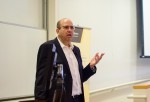A UCLA technology development expert said the public and private sectors should collaborate more with universities to encourage innovation and research on campus.
Amir Naiberg, president and CEO of UCLA Technology Development Group, compared the process of technology transfer between universities and the private sector in the United States and Israel on Wednesday at an event organized by the UCLA Younes & Soraya Nazarian Center for Israel Studies. Technology transfer is the process whereby ideas developed in university research labs become products sold by for-profit companies.
Naiberg, who also leads the Technology Development Group at UCLA, said Israel has a more rigid, bureaucratic technology transfer structure while American companies have more flexible partnerships with universities. He said he thinks the U.S. and Israel share similar goals and principles in trying to strengthen the relationship between universities and the public and private sectors to promote innovation, research and entrepreneurship.
Technology transfer begins at the university level and ends with commercialization of research, Naiberg said.
“Research institutions like universities are innovation banks,” Naiberg said.
Before 1980, federal agencies, rather than universities, generated most of the capital for research meant to be commercialized in the United States, Naiberg said. He added most universities did not have technology transfer offices, which limited the commercialization of patents.
“As a result, only five percent of patents were ever commercialized, which led to very few products, jobs, or other public benefits,” he said.
However, a new federal policy in 1980 allowed researchers to profit from inventions, which also helped drive the economy and allowed for the production of new technology that protected public health, Naiberg said.
Naiberg added UCLA has since developed 900 forms of technology in areas such as entertainment and digital media, advanced transportation, aerospace and defense and biotechnology.
UCLA-affiliated medical products have saved or extended the lives of approximately 600,000 cancer patients, Naiberg said. He added he expects this figure to reach one million in the near future.
Naiberg said UCLA’s research is strong because of the collaboration between its various STEM departments. He added that federal funding can also effectively promote innovation and entrepreneurship.
However, Naiberg said there is a funding gap known as the valley of death between academic grants and industry investment as universities receive significantly less funding than private companies.
He said universities typically stop receiving academic funding once the basic research step of a project is completed. However, other sources like the UCLA Fund for Innovation aim to bridge this gap in funding so that researchers have the means to further develop their technology and eventually commercialize it.
Jack Schwada, communications manager for the Nazarian Center, said in an email statement that the center held the event so students could learn about the issue of technology transfer in the United States and Israel to see how innovation works in both countries.
Naiberg said it is important for UCLA students who are ready to join the workforce to understand technology transfer so they can keep up with a changing economy.
Andrew Dale, a graduate student at the Anderson School of Management, said he is interested in technology transfer and commercial research done at UCLA specifically because he is part of an investment group that looks for investment opportunities near UCLA.
“I am curious about the university’s plans for commercialization and how the revenues and partnerships from the Technology Development Group will be used to support the school with research and just more generally,” he said.
Dale, who is a vice president of impact investing at Anderson Venture Impact Partners, added he is always on the lookout for new early-stage companies to invest in and finds the idea of working within the UCLA community to find new opportunities very exciting.
Naiberg said UCLA is currently seeing a technology rush, as many people are moving to California to start small businesses based on research done on campuses like UCLA. He added 138 California companies have commercialized UCLA research.
“Being next to UCLA has amazing perks because of its great research institute, ” Naiberg said.
